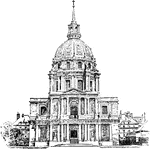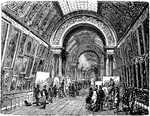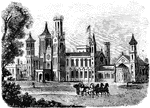Museums
The Museums ClipArt gallery includes 23 views of various art, history, natural history, military, and scientific museums around the world.

Chicago Art Institute
The Art Institute of Chicago is one of America's premier fine art museums. It was founded in 1879.
![The Musée du Louvre or officially the Grand Louvre — in English, the Louvre Museum or Great Louvre, or simply the Louvre — is the national museum of France, the most visited museum in the world, and a historic monument. It is a central landmark of Paris, located on the Right Bank of the Seine in the 1st arrondissement (neighborhood). Nearly 35,000 objects from the 6th century BC to the 19th century are exhibited over an area of 60,600 square meters (652,300 square feet)."Du Cerceau, who flourished during the reign of Henry IV., connected the block of buildings which belong to the Louvre, and had been constructed under Catherine dei Medici, by a gallery with the Tuileries [shown here]. This architect abandoned the characteristic feature of the French Renaissance, which had prevailed hitherto, namely, of giving its peculiar columnar order to each storey, and assimilated his designs to those of the late Roman Renaissance, in which a striking effect was produced at the expense of truth by continuous columns and pilasters extending over several storeys and rows of windows."](https://etc.usf.edu/clipart/73700/73745/73745_flore_pavili_mth.gif)
Flore Pavilion and part of the Gallery of the Louvre
The Musée du Louvre or officially the Grand Louvre — in English, the Louvre Museum or Great Louvre,…
![The Musée du Louvre or officially the Grand Louvre — in English, the Louvre Museum or Great Louvre, or simply the Louvre — is the national museum of France, the most visited museum in the world, and a historic monument. It is a central landmark of Paris, located on the Right Bank of the Seine in the 1st arrondissement (neighborhood). Nearly 35,000 objects from the 6th century BC to the 19th century are exhibited over an area of 60,600 square meters (652,300 square feet).Charles Le Brun (February 24 1619 – February 22 1690) was a French painter and art theorist, one of the dominant artists in 17th century France."Little by little a method of ornamentation was introduced by successive decorators and architects, which was eminently suited to the French taste. Androuet Du Cercean and Jean Lepautre are especially noticeable as representatives of this school of establishment. The sumptuous Apollo Gallery in the Louvre is a characteristic example of the productions of the latter. [This image] exhibits a portion of the system of decoration which pervades the whole gallery."](https://etc.usf.edu/clipart/73700/73725/73725_lebrun_charl_mth.gif)
Fragment from the Apollo Gallery in the Louvre at Paris
The Musée du Louvre or officially the Grand Louvre — in English, the Louvre Museum or Great Louvre,…

Glyptothek at Munich
"In contrast to the Berlin school is that of Munich, which was founded by Gärtner. Its influence, which…

Glyptothek
The Glyptothek is a museum in Munich, Germany, which was commissioned by the Bavarian King Ludwig I…

Hotel de Cluny
An illustration of the Hotel de Cluny in Paris, France. The Hotel de Cluny is a small palace from the…

Church of the Hotel des Invalides
An illustration of the Church of the Hotel des Invalides located in the 7th arrondissement of Paris,…
![Les Invalides in Paris, France, is a complex of buildings in the city's 7th arrondissement containing museums and monuments, all relating to the military history of France, as well as a hospital and a retirement home for war veterans. The buildings house the Musée de l'Armée, the military museum of the Army of France, the Musée des Plans-Reliefs, and the Musée d'Histoire Contemporaine, as well as the burial site for some of France's war heroes, notably Napoleon Bonaparte."The principal architectural activity of this period was displayed by Jules Hardouin Mansard, who was head architect to the king and the head of the influential school, as Lenôtre at the same time was principal horticulturist. Mansard built the palaces of Versailles (1647-1708, Marly, the Grand Trianon, as also the Invalides at Paris [shown here]."](https://etc.usf.edu/clipart/73700/73748/73748_invalides_mth.gif)
Invalides at Paris
Les Invalides in Paris, France, is a complex of buildings in the city's 7th arrondissement containing…

Hôtel des Invalides
A complex of buildings containing museums and monuments, all relating to the military history of France.…

Bird's Eye View of the Louvre
An illustration of the Louvre Museum in Paris, France from a bird's-eye view. The Louvre is one of the…
!["The change from the pure to the later Renaissance, which was formerly seen only in individual instances, has now received a certain extension. This is mainly owing to the key-note struck in the New Louvre [shown here], begun by Visconti, but finished by another architect. Although it is true that the new building conforms in general to the architecture of the Old Louvre, yet still an increase rather than a decrease is to be perceived in the effort for picturesque effect, in the licence of the Roccoco style, and in an unstructural treatment of the individual forms and ornamental parts."](https://etc.usf.edu/clipart/73800/73804/73804_louvre_corne_mth.gif)
Corner Pavilion of the New Louvre
"The change from the pure to the later Renaissance, which was formerly seen only in individual instances,…
![The Musée du Louvre or officially the Grand Louvre — in English, the Louvre Museum or Great Louvre, or simply the Louvre — is the national museum of France, the most visited museum in the world, and a historic monument. It is a central landmark of Paris, located on the Right Bank of the Seine in the 1st arrondissement (neighborhood). Nearly 35,000 objects from the 6th century BC to the 19th century are exhibited over an area of 60,600 square meters (652,300 square feet).The Louvre was built by "three prominent architects, [one of which was] Pierre Lescot (1510-1578), who desiged the celebrated Western Façade of the Louvre [shown here]."](https://etc.usf.edu/clipart/73700/73722/73722_louvre_facad_mth.gif)
Inner Façade of the Louvre
The Musée du Louvre or officially the Grand Louvre — in English, the Louvre Museum or Great Louvre,…
![The Musée du Louvre or officially the Grand Louvre — in English, the Louvre Museum or Great Louvre, or simply the Louvre — is the national museum of France, the most visited museum in the world, and a historic monument. It is a central landmark of Paris, located on the Right Bank of the Seine in the 1st arrondissement (neighborhood). Nearly 35,000 objects from the 6th century BC to the 19th century are exhibited over an area of 60,600 square meters (652,300 square feet).The Louvre was built by "three prominent architects, [one of which was] Pierre Lescot (1510-1578), who desiged the celebrated Western Façade of the Louvre [shown here]."](https://etc.usf.edu/clipart/73700/73723/73723_louvre_facad_mth.gif)
Inner Façade of the Louvre
The Musée du Louvre or officially the Grand Louvre — in English, the Louvre Museum or Great Louvre,…

Gallery in the Louvre
An illustration of one of the galleries in the Louvre in Paris, France. The Louvre is one of the world's…

Petit Palais
The Petit Palais (Small Palace) is a museum in Paris, France. It was built for the Universal Exhibition…
![The Musée du Louvre or officially the Grand Louvre — in English, the Louvre Museum or Great Louvre, or simply the Louvre — is the national museum of France, the most visited museum in the world, and a historic monument. It is a central landmark of Paris, located on the Right Bank of the Seine in the 1st arrondissement (neighborhood). Nearly 35,000 objects from the 6th century BC to the 19th century are exhibited over an area of 60,600 square meters (652,300 square feet)."Du Cerceau, who flourished during the reign of Henry IV., connected the block of buildings which belong to the Louvre, and had been constructed under Catherine dei Medici, by a gallery with the Tuileries. This architect abandoned the characteristic feature of the French Renaissance, which had prevailed hitherto, namely, of giving its peculiar columnar order to each storey, and assimilated his designs to those of the late Roman Renaissance, in which a striking effect was produced at the expense of truth by continuous columns and pilasters extending over several storeys and rows of windows.Although Du Cerceau was obligated to leave France in the year 1604, the impulse which he had given in the direction of the above-mentioned manner led to its being generally adopted. The new buildings were more correct, but less picturesque than those built during the earlier period of the French Renaissance, and a certain insipidity seems to characterize the various structures erected during the reigns of Henry IV., and especially Louis XIII. As is shown [here], a combination of free-stone and brick was restored to in such a way that the former was employed for the mouldings, and for the quoins and dressings of the doors and windows, whilst brick was used for the spaces between. In the case of the windows the free-stone introduced assumed the forms of quoins. If ornamentation had been previously excessive, it now retired into the background, and was only employed in moderation; and the method of its treatment began to be distinguished from that of the former period. The forms of the details above all began to lose in purity: rustications were inappropriately introduced in the walls and columns, and the roofs were made high and steep, which gave the rest of the building a heavy and squat appearance, whilst the numerous turret-shaped chimneys, which were necessitated by these high roofs, formed a peculiar feature in the construction."](https://etc.usf.edu/clipart/73700/73746/73746_royal_palace_mth.gif)
Paris, Royal Palace Façade
The Musée du Louvre or officially the Grand Louvre — in English, the Louvre Museum or Great Louvre,…

Pinacothek
The Alte Pinakothek (Old Pinakothek) is an art museum situated in the Kunstareal in Munich, Germany.…

A Roman Temple
"The best preserved of Roman temples. Located at Nimes in southern France, where it is known as La Maison…
![The Musée du Louvre or officially the Grand Louvre — in English, the Louvre Museum or Great Louvre, or simply the Louvre — is the national museum of France, the most visited museum in the world, and a historic monument. It is a central landmark of Paris, located on the Right Bank of the Seine in the 1st arrondissement (neighborhood). Nearly 35,000 objects from the 6th century BC to the 19th century are exhibited over an area of 60,600 square meters (652,300 square feet).The three prominent architects, Pierre Lescot (1510-1578), who desiged the celebrated Western Façade of the Louvre, Philibert Delorme and Jean Buillant, who was the architect of the earlier portions of the Tuileries [shown here], and of the Château d'Ecouen, exerted such an influence over the architecture of their native country that the Italian Renaissance Style became thenceforward the predominant one in France."](https://etc.usf.edu/clipart/73700/73724/73724_tuileries_fa_mth.gif)
Façade of the Tuileries
The Musée du Louvre or officially the Grand Louvre — in English, the Louvre Museum or Great Louvre,…
![Wollaton Hall is a country house standing on a small but prominent hill in Wollaton, Nottingham, England. Wollaton Park is the area of parkland that the stately house stands in. The house itself is a natural history museum, with other museums in the out-buildings. The surrounding land is regularly used for large scale outdoor events such as rock concerts and festivals."It is especially this vitiated taste in form and details which characterized the Elizabethan Renaissance [shown here]. The usual Roccoco Renaissance forms also occur in it, as, for instance, the quadrant-shaped gables curving alternately inwards and outwards, as also pilasters and columns intersected by quoins and bands; and various grotesque and debased forms. Enriched quoins are also freely used at angles and jambs."](https://etc.usf.edu/clipart/73700/73787/73787_wollaton_hal_mth.gif)
Wollaton Hall
Wollaton Hall is a country house standing on a small but prominent hill in Wollaton, Nottingham, England.…


